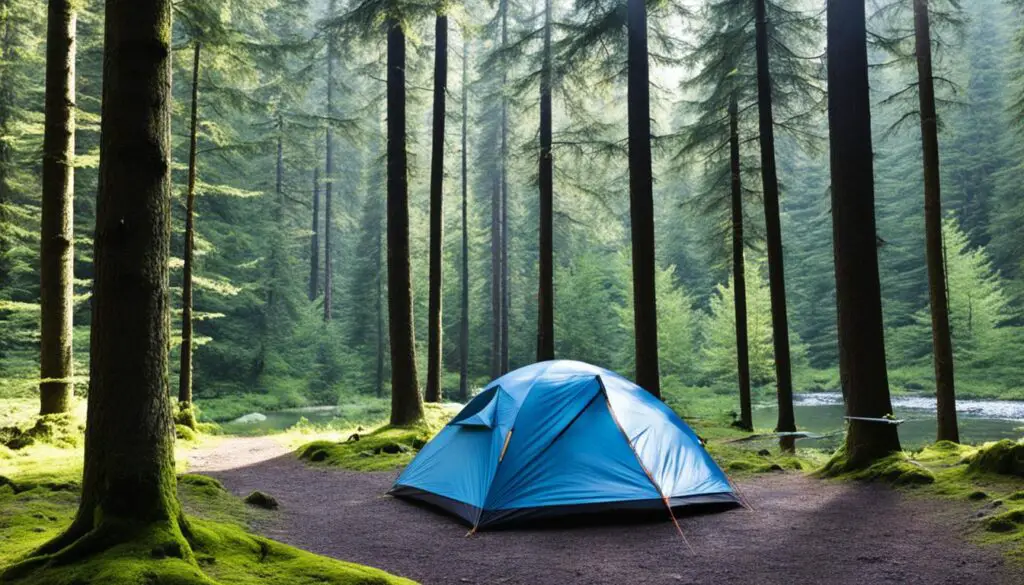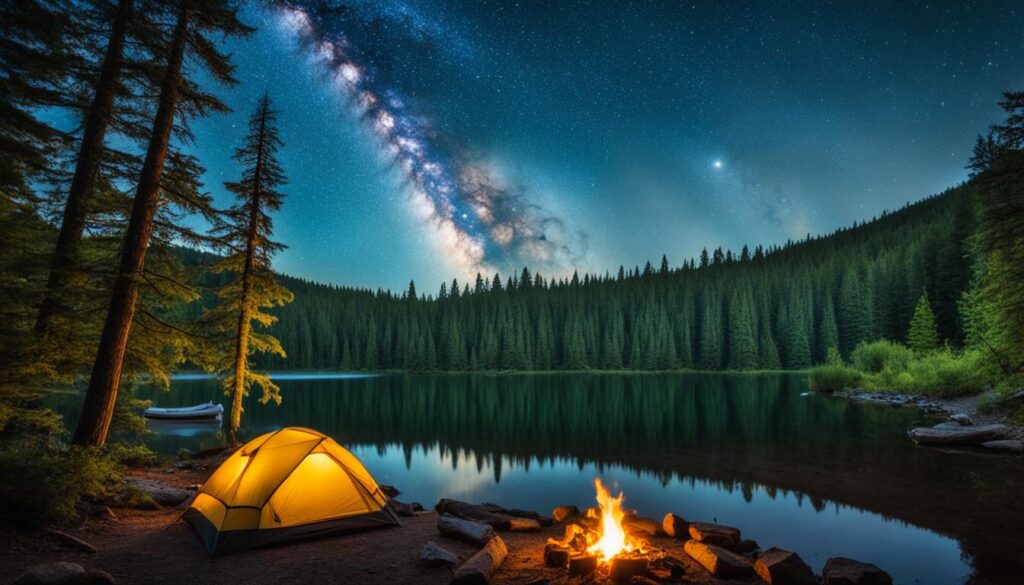Can You Camp Not in a Campsite
I love exploring the outdoors, moving beyond regular campsites. Finding hidden gems, enjoying nature’s beauty, and seeking adventures off the usual path captivates me. In this article, I’ll cover everything about dispersed camping, from the rules to staying safe and the best ways to enjoy it.
We’ll talk all about the rules of dispersed camping and what gear you need. I’ll also share tips for camping responsibly, making sure we protect the places we visit. Plus, we’ll check out amazing spots to experience the wilderness at its best.
Introduction: Exploring the World of Non-Campsite Camping
Venturing beyond traditional campsites brings new adventure and freedom. Non-campsite or dispersed camping is about immersing in wild beauty. It’s away from the crowd, where you leave the convenience of normal campsites.
Uncovering the Allure of Off-the-Beaten-Path Adventures
Non-campsite camping offers the thrill of exploring and relying on yourself. Imagine waking with nature’s sounds, seeing no tents, just the great outdoors. It lets you leave stress behind and deepens your connection with nature.
Understanding the Rules and Regulations Surrounding Dispersed Camping
Freedom in non-campsite camping is exciting. But knowing the rules is crucial. Rules differ by location and land agency. So, always check the guides for where you are going. This ensures a fun, safe, and respectful trip for all.
Following rules and exploring well opens up amazing non-campsite adventures. You’ll make memories that regular campsites just can’t beat.
Can You Camp Not in a Campsite?
The rules for dispersed camping, or camping away from campsites, can seem unclear. Yet, the simple answer to “Can you camp not in a campsite?” is yes, with some rules. Different places have their own laws on off-grid camping and primitive camping.
In the U.S., you can usually camp off-site on public lands like national forests and BLM areas. They allow off-the-beaten-path camping if you’re careful about the nature. But, always check the area’s specific rules before you go. Some places might need you to get a permit or have extra rules on primitive camping.
On private land, though, camping without permission is trespassing and illegal. It’s important to stay on public land or get the clear okay to camp on someone’s private land.
When debating, is dispersed camping legal, being informed and responsible is key. Knowing the laws on off-grid camping and where you can camp without a site is essential. This helps you enjoy the adventure while respecting all 
The real fun of off-the-beaten-path adventures comes from caring for the land. Always leave no trace, follow the rules, and be kind to the environment. This way, you’ll have amazing adventures and help protect these places for the future.
Essential Gear for Non-Campsite Camping
Heading off-the-grid for camping needs good preparation and the right tools. The aim with gear for dispersed camping is to travel light. Yet, you must make sure to bring what is needed for comfort and safety outdoors. Let’s go over the must-have items in your wilderness camping essentials list.
Packing Light and Preparing for the Unexpected
Minimizing the weight of your gear is key for camping away from sites. Since you carry everything in a backpack or car, less is more for ease. Begin with things like a sturdy yet light dispersed camping gear, for instance, a tough tent.
Then, having a good off-grid camping equipment stove and fuel is important. Pick ones that are small, efficient, and can cook your meals. For clean water to drink, a solid purification system is a must. Either a filter or purification tablets will do the job well.
- Lightweight, compact tent
- Efficient camp stove and fuel
- Water purification system
- Portable power source (e.g., solar charger, power bank)
- First-aid kit and essential survival gear
- Navigation tools (e.g., compass, map, GPS device)
Don’t miss a portable power source, like a solar charger, to juice up your gear. Also, a full first-aid kit and key survival tools can be lifesavers when things don’t go as planned.
By choosing wisely and packing light, you’re all set for non-campsite adventures. They’ll help you face the hurdles and relish the great outdoors in a whole new way.
Responsible Practices for Minimizing Your Impact
Exploring leave no trace camping and dispersed camping means protecting the environment. What we do in nature can help or harm the plants and animals there.
Leave no trace camping reminds us to be careful. It tells us to keep the wilderness pure for others in the future.
Embracing the Leave No Trace Ethos
The key to caring for nature while camping is “Leave No Trace.” This way teaches us to:
- Think and get ready ahead of time to lower our impact
- Throw away trash safely, so our visit isn’t seen
- Give wildlife space and keep their homes safe
- Limit fire damage and put fires out well
- Walk on hard ground to not hurt the earth much
- Don’t take anything from nature, so it stays pretty for all
By following these rules, we do our part for keeping the wild around us safe.
Practical Tips for Responsible Camping
Being a good leave no trace camping camper means being careful in all we do outdoors. Here are tips for lessening our effect:
- Pick a spot for camping where others have already been, so we cause less trouble.
- Get rid of human waste right and take all garbage with us, like food leftovers and toilet paper.
- Don’t hurt plants or trees, and watch our steps to help nature stay nice.
- Stay away from wildlife and don’t give them food or try to get closer.
- Put out fires really well when done, making sure they’re all the way out.
Following these good ways, our dispersed camping times make nature better instead of worse.
How we act outside matters a lot. Living by a leave no trace attitude guards the world’s beauty for all of us and our kids to enjoy.
Discovering the Best Spots for Dispersed Camping
Want to know where the best dispersed camping spots are? Look into public lands first. This includes national forests, BLM areas, plus some state parks and wildlife spots. Most of these places let you camp for free out in the wild, but sometimes you must pay a small fee for a campsite.
Researching Public Lands and Respecting Private Property
To find great dispersed camping spots, start with maps and info from the U.S. Forest Service and BLM. They tell you where camping is allowed and if there are any rules you need to follow. Sites like Campendium and Escape Campervans can also help you find the best off-grid spots across the U.S.
Even with lots of public land for dispersed camping, remember to stay away from private property. If you want to camp on someone’s private land, ask for their permission first. This keeps you out of trouble and shows respect for both the land and its owners.
FAQ
Can I camp outside of a designated campsite?
It depends on where you want to camp. Some places, like national forests and BLM lands, allow it. But, you must follow special rules.
What are the rules and regulations for dispersed camping?
Rules for camping off campsites differ by place. You should always “Leave No Trace.” This means leaving nothing behind and being careful not to harm the environment.
What essential gear do I need for non-campsite camping?
For off-campsite camping, bring important items. These include a good tent, a stove, clean water tools, and navigation equipment. Being ready for anything is very important.
How can I minimize my impact when camping in the wilderness?
To protect the wilderness, follow the “Leave No Trace” rules. This means throwing away trash properly and not hurting the land. Remember, we should leave nature as we find it.
Where can I find the best spots for dispersed camping?
Start by looking at national forests and BLM lands. They often allow non-campsite camping. Always follow the rules and get any needed permits. Good planning helps find great camping places.
